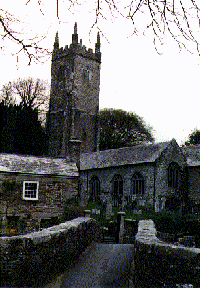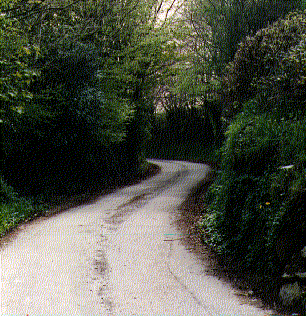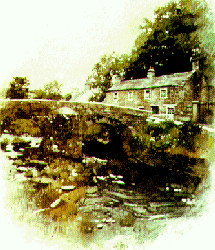A TRIBUTE TO ALTARNUN
Only visited by way of words, though my
ancestors once lived there; some day, maybe, I will visit Altarnun myself
for real.
ALTARNUN, CORNWALL, ENGLAND is 7-8 miles west of Launceston, about
10 miles east of Camelford, and rests on the upper bounds of the Bodmin
Moors. The immediate surrounding Parishes are Trewen, Lewanick, and Northill
on the east, St. Cleer and St. Neot on the south, Blisland and St. Breward on
the west, and St. Clether and Laneast on the north. The Parish is variously
spelled i.e. Alternon, as are other spellings of the surrounding parishes. A
more ancient report per Hals reports that Altar Nun is situate in the hundred
of Losnewth, and hath upon the north Davidstow and St. Cleather, south part of
Northill and Lawanack, east Trewenn, west Temple, and was taxed in Domesday
Roll either under the name of Trewint, Treuint, the spring, fountain, or well
town, situate upon the fens or springs, otherwise under the jurisdiction of
Trewen. Many of these Parishes record my ancestral names as well does
Altarnun.
A modern description of Altarnun states the following. Cottages of slate and
granite line Altarnun's single winding street, and by the entrance to the
churchyard a medieval packhorse bridge crosses the peat-stained stream known
as Penpont Water. The village lies just off the main road which descends the
north-eastern flanks of Bodmin Moor, and is the center of Cornwall's largest
parish.
 Altarnun's old moorstone church, known as 'The Cathedral, of the Moors'
because of its size, is dedicated to St Nonna, mother of
St. David of Wales.
It is with this reference that Tonkin states, 'It is obvious to anyone, that
the name of this parish can signify no other than an alter or church dedicated
to St. Nunne, which St. Nunne, being in some accounts called Naunita or
Nannites, and in other Novita, is said to have been the daughter of an earl of
Cornwall, and mother of St. David the famous archbishop of Menevia, from him
called St. David's. While obvious to Tonkin, Carew in his Survey of Cornwall
speculated that the name derived from the Altar of St. Nun's pool in the
parish, as heretofore it was much frequented for the cure of mad people. Yet
Hals conceived the word Altar as Alter, as a previous chapel pertaining to
nuns or nunnery was once there and it had been converted to a vicarage
church; thus Alter - Nun or Nunnery. Take your pick as to the origin of the
name Altarnun.
Altarnun's old moorstone church, known as 'The Cathedral, of the Moors'
because of its size, is dedicated to St Nonna, mother of
St. David of Wales.
It is with this reference that Tonkin states, 'It is obvious to anyone, that
the name of this parish can signify no other than an alter or church dedicated
to St. Nunne, which St. Nunne, being in some accounts called Naunita or
Nannites, and in other Novita, is said to have been the daughter of an earl of
Cornwall, and mother of St. David the famous archbishop of Menevia, from him
called St. David's. While obvious to Tonkin, Carew in his Survey of Cornwall
speculated that the name derived from the Altar of St. Nun's pool in the
parish, as heretofore it was much frequented for the cure of mad people. Yet
Hals conceived the word Altar as Alter, as a previous chapel pertaining to
nuns or nunnery was once there and it had been converted to a vicarage
church; thus Alter - Nun or Nunnery. Take your pick as to the origin of the
name Altarnun.
Knowing that there has been a historical relationship between Cornwall and
Wales, and there are Welsh influences in Cornish history, I would think the
St. David Patron Saint of Wales story holds the most water. But perhaps I am
prejudiced by my own Welsh origins via my Hendower
descent.
Just inside the churchyard is a stout Celtic cross, said to date from the
6th century. The 15th-century church contains 79 original oak carved
bench-ends depicting travelling musicians and entertainers, local characters
of the time, and a flock of sheep. One of the bench ends near the south door
has carved on it, 'Robert Daye maker of this work & William Bokyngham,
Curate, John Hodge, clarke, an. M.D.' - (1500). The tower of the church is
110 feet high, and is considered to be the highest in the county except for
that at Probus. At least it was at the time of the referenced writing.
What mysteries lie at the end of your benches? Who is to be found resting in
your yard? What old structures and places still exist of old? What families
if any do still there remain? For a short time's stay could I find this out.
From Those Who Have Visited There!
 "It was a fantastic experience visiting
that region of Cornwall. North Hill,
Lewannick and Altarnun have probably
changed little over the past few cen-
turies. The roads connecting the
villages are very narrow with high
hedges on both sides and little alcoves
to allow cars to pass (that is, cars
coming the other way!). The villages
are only a mile or so apart. Visiting
the churches and the churchyards is a
special experience. And the surrounding
farms bear the same names as they did
in the 17th Century wills of several of
my other ancestors from that area. You
may have deduced that we are very fond
of the area!"
"It was a fantastic experience visiting
that region of Cornwall. North Hill,
Lewannick and Altarnun have probably
changed little over the past few cen-
turies. The roads connecting the
villages are very narrow with high
hedges on both sides and little alcoves
to allow cars to pass (that is, cars
coming the other way!). The villages
are only a mile or so apart. Visiting
the churches and the churchyards is a
special experience. And the surrounding
farms bear the same names as they did
in the 17th Century wills of several of
my other ancestors from that area. You
may have deduced that we are very fond
of the area!"
- David and Lynette Hall
- dhall@enternet.com.au
While seeming at the very heart of being devoted to the Church of England,
the Methodist preacher
John Wesley often visited Altarnun, staying at nearby
Trewint in a house which is now a Methodist museum. Altarnun's Georgian
Meeting House has a carved stone effigy of Wesley above the door, the work
of the local sculptor Nevil Burnard, who was born in 1818.
 Halfway across Bodmin Moor,
about 4 miles south-west of Altarnun, is the
hamlet of Bolventor and the slate-hung Jamaica Inn. The inn was built in
the late 18th century and served as a resting place for travellers, but it
became notorious as a meeting place for smugglers, whose activities Daphne
Halfway across Bodmin Moor,
about 4 miles south-west of Altarnun, is the
hamlet of Bolventor and the slate-hung Jamaica Inn. The inn was built in
the late 18th century and served as a resting place for travellers, but it
became notorious as a meeting place for smugglers, whose activities Daphne
 du Maurier featured in her novel, Jamaica Inn. Jamaica Inn is also one of
my favorite movies, as it not only features Jane Seymour, but it also shows
the landscapes of the Bodmin Moor and Altarnun, and it has the pronunciation
some of those Cornish place names that seem to be spelled one way but
pronounced another. If you don't know, how would you pronounce Launceston?
Watch the movie and see if you can pick it out.
du Maurier featured in her novel, Jamaica Inn. Jamaica Inn is also one of
my favorite movies, as it not only features Jane Seymour, but it also shows
the landscapes of the Bodmin Moor and Altarnun, and it has the pronunciation
some of those Cornish place names that seem to be spelled one way but
pronounced another. If you don't know, how would you pronounce Launceston?
Watch the movie and see if you can pick it out.
The view to the north from Bolventor takes in the 1,377 ft rocky tor of Brown
Willy, Cornwall's highest point. Brown Willy is a corruption of the Cornish
Bron Ewhella, which means 'highest hill'. About 1 mile south-east of Bolventor
lies Dozmary Pool, said to be where King Arthur's sword, Excalibur, was received
by a hand rising from the water. According to legend, the pool is bottomless.
In fact, it is only 9 in. deep. Another legend tells of Jan Tregeagle, an
unpopular local magistrate whose spirit was condemned to perform several
impossible tasks, including emptying Dozmary Pool with a leaky limpet shell.
 Here a picture depicts village stream stone cottages facing the ancient
packhorse bridge which links the hillside village of Altarnun with its
church, and which stands on the other side of Penpont Water.
Here a picture depicts village stream stone cottages facing the ancient
packhorse bridge which links the hillside village of Altarnun with its
church, and which stands on the other side of Penpont Water.
Some more interesting history and traditions of the Parish of Altarnun records
in this parish stands the barton of Trelawny, i.e. the oak grove town, or, "I
am the oak grove town." This name as first given is taken from the natural
circumstances of the place, as it is situate between two hills which where then
notable for woods or groves of oak timber. In one translation Hendar or
Hendre is taken to mean 'Old' - 'Hen', 'Oak' - 'Dar/Dre.' This seems to
perplex the researchers of my family name 'Hender' to no end, though it is
previously and historically shown to derive from another source entirely.
Another story of antiquity reports that parish land of Altarnun was denominated
by that old and famous family of gentlemen surnamed Trelawney, now baronets.
And that one Sir William de Trelawny, lord of this place, suffered it to go in
marriage with his base daughter, to _______, from whose hears by descent or
purchase, it came to Cloberry Hicks.
Contemporary with Charles II, lived Peter Jowle or Jowll under clerk or deacon of
this
church, who was 150 and odd years old when he died, and at the age of 100 years
had new black hairs that sprung forth on his head amongst those that long
before were white with age. Perhaps St. Nun's Pool cured more than madness,
and for the pure in heart is also a fountain of youth? Anyway as the story
continues, it seems that Peter Jowle at age 100 also grew new teeth in the
places where others had long fallen out of his head.
Tin lodes and streams are Altarnun's named resources. What else from
there has sprung?
* (Apreciation goes to David and Lynette Hall for description and pictures provided.)
Altarnun Connects on the Net
new e-mail to come
You may Speak to Me by way of this mail-link if You wish.
 Altarnun's old moorstone church, known as 'The Cathedral, of the Moors'
because of its size, is dedicated to St Nonna, mother of
St. David of Wales.
It is with this reference that Tonkin states, 'It is obvious to anyone, that
the name of this parish can signify no other than an alter or church dedicated
to St. Nunne, which St. Nunne, being in some accounts called Naunita or
Nannites, and in other Novita, is said to have been the daughter of an earl of
Cornwall, and mother of St. David the famous archbishop of Menevia, from him
called St. David's. While obvious to Tonkin, Carew in his Survey of Cornwall
speculated that the name derived from the Altar of St. Nun's pool in the
parish, as heretofore it was much frequented for the cure of mad people. Yet
Hals conceived the word Altar as Alter, as a previous chapel pertaining to
nuns or nunnery was once there and it had been converted to a vicarage
church; thus Alter - Nun or Nunnery. Take your pick as to the origin of the
name Altarnun.
Altarnun's old moorstone church, known as 'The Cathedral, of the Moors'
because of its size, is dedicated to St Nonna, mother of
St. David of Wales.
It is with this reference that Tonkin states, 'It is obvious to anyone, that
the name of this parish can signify no other than an alter or church dedicated
to St. Nunne, which St. Nunne, being in some accounts called Naunita or
Nannites, and in other Novita, is said to have been the daughter of an earl of
Cornwall, and mother of St. David the famous archbishop of Menevia, from him
called St. David's. While obvious to Tonkin, Carew in his Survey of Cornwall
speculated that the name derived from the Altar of St. Nun's pool in the
parish, as heretofore it was much frequented for the cure of mad people. Yet
Hals conceived the word Altar as Alter, as a previous chapel pertaining to
nuns or nunnery was once there and it had been converted to a vicarage
church; thus Alter - Nun or Nunnery. Take your pick as to the origin of the
name Altarnun. "It was a fantastic experience visiting
that region of Cornwall. North Hill,
Lewannick and Altarnun have probably
changed little over the past few cen-
turies. The roads connecting the
villages are very narrow with high
hedges on both sides and little alcoves
to allow cars to pass (that is, cars
coming the other way!). The villages
are only a mile or so apart. Visiting
the churches and the churchyards is a
special experience. And the surrounding
farms bear the same names as they did
in the 17th Century wills of several of
my other ancestors from that area. You
may have deduced that we are very fond
of the area!"
"It was a fantastic experience visiting
that region of Cornwall. North Hill,
Lewannick and Altarnun have probably
changed little over the past few cen-
turies. The roads connecting the
villages are very narrow with high
hedges on both sides and little alcoves
to allow cars to pass (that is, cars
coming the other way!). The villages
are only a mile or so apart. Visiting
the churches and the churchyards is a
special experience. And the surrounding
farms bear the same names as they did
in the 17th Century wills of several of
my other ancestors from that area. You
may have deduced that we are very fond
of the area!" Halfway across Bodmin Moor,
about 4 miles south-west of Altarnun, is the
hamlet of Bolventor and the slate-hung Jamaica Inn. The inn was built in
the late 18th century and served as a resting place for travellers, but it
became notorious as a meeting place for smugglers, whose activities Daphne
Halfway across Bodmin Moor,
about 4 miles south-west of Altarnun, is the
hamlet of Bolventor and the slate-hung Jamaica Inn. The inn was built in
the late 18th century and served as a resting place for travellers, but it
became notorious as a meeting place for smugglers, whose activities Daphne
 du Maurier featured in her novel, Jamaica Inn. Jamaica Inn is also one of
my favorite movies, as it not only features Jane Seymour, but it also shows
the landscapes of the Bodmin Moor and Altarnun, and it has the pronunciation
some of those Cornish place names that seem to be spelled one way but
pronounced another. If you don't know, how would you pronounce Launceston?
Watch the movie and see if you can pick it out.
du Maurier featured in her novel, Jamaica Inn. Jamaica Inn is also one of
my favorite movies, as it not only features Jane Seymour, but it also shows
the landscapes of the Bodmin Moor and Altarnun, and it has the pronunciation
some of those Cornish place names that seem to be spelled one way but
pronounced another. If you don't know, how would you pronounce Launceston?
Watch the movie and see if you can pick it out. Here a picture depicts village stream stone cottages facing the ancient
packhorse bridge which links the hillside village of Altarnun with its
church, and which stands on the other side of Penpont Water.
Here a picture depicts village stream stone cottages facing the ancient
packhorse bridge which links the hillside village of Altarnun with its
church, and which stands on the other side of Penpont Water.